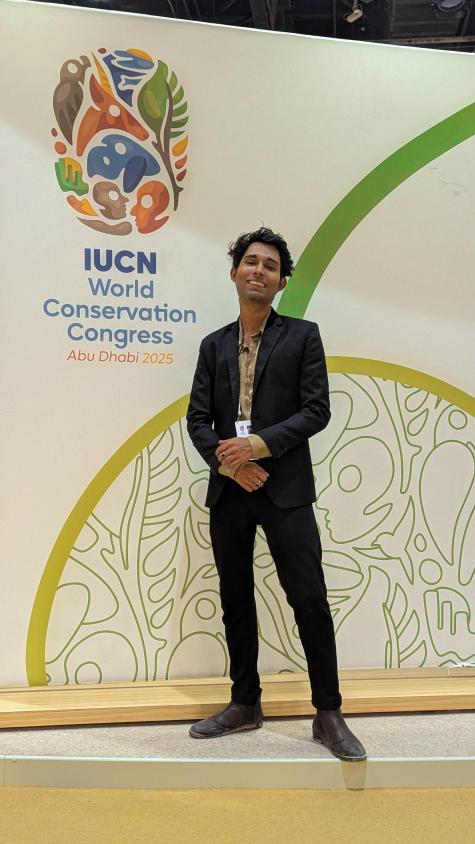IUCN World Conservation Congress

IUCN World Conservation Congress
The World Conservation Congress is held every four years by the International Union for Conservation of Nature (IUCN).
The Congress is also the world’s largest conservation event, which will bring together several thousand leaders and decision-makers from government, civil society, indigenous peoples, business, and academia to determine how we can use nature to overcome the crisis that humanity has created for itself. The Congress aims to improve how we sustain our natural world for human, social, and economic development, yet it must be done by conservationists working with multiple stakeholders from the government and civil society alike having shared objectives.
In 2025 the World Conservation Congress was held in Abu Dhabi from 9th to 15th October. It provided a crucial global platform to forward international discourse on global environmental governance. This year the theme of the World Conservation Congress was ‘Powering Transformative Conservation’. Hosted for the very first time in the United Arab Emirates, the Congress witnessed the participation of an estimated 10000 delegates from 189 countries to engage and tackle some of the most pressing environmental challenges the world is facing today.
History of IUCN and the World Conservation Congress
Founded in 1948, the International Union for Conservation of Nature (IUCN) is now a worldwide union with 78 states, 112 government agencies, 735 non-governmental agencies (of which 65 are international), 35 observers, and nearly 10,000 scientists and experts from 181 countries. It is one of the few international organizations that counts both state agencies and non-governmental organizations as members and it facilitates a middle ground where both sides can meet and share perspectives in order to map out common action.
IUCN, which is the world’s apex environmental decision making forum, held the inaugural Congress in 1996 in Montreal, but prior to that IUCN had held 19 general assemblies. These general assemblies adopted hundreds of resolutions and recommendations, influencing the course of conservation action locally, nationally and internationally in addition to setting the tone for the upcoming Congresses.
Voting on Motions
Key decisions are made by the member’s assembly through voting on motions, which upon approval by the members become resolutions and recommendations steering the general policy of IUCN. The Resolutions Committee is tasked with admitting motions which are then deliberated and voted on. In 2025, members were invited to participate in the electronic vote on 97 motions that the Motions Working Group had forwarded to the ballot following an online discussion.
*****

World Conservation Congress 2025
The 8th Congress of the International Union for Conservation of Nature (IUCN) happened in Abu Dhabi from the 9th to 15th of October, 2025. The 8th World Conservation Congress held in Abu Dhabi National Exhibitions Center (ADNEC) was the first ever to have a World Summit of Indigenous Peoples and Nature. Having seen a record level of participation of 10000 participants in both online and in-person attendance, this year the World Conservation Congress has set new records in taking forward the worldwide collective action in environmental as well as species conservation. This year, Her excellency Razan Khalifa Al Mubarak has been elected as the President of the Union. She serves as the Managing Director for the Environment Agency of Abu Dhabi.
20 Year Vision and Four Year Programme for IUCN
The strategic vision is underscored by IUCN’s unique position at the helm of driving change and impact by scaling up existing conservation work and addressing the key drivers of biodiversity loss across eight transformational interlinked paradigms of climate change, energy transition, economic and financial domains like agriculture, health and water.
The Programme sets out a strategy, as well as responsible deliverables, to catalyse global conservation action during the coming 4 years. Having a local to global mandate it will facilitate on-the-ground effect by mobilising and aligning resources to where they are most required, building frontline conservationists' capacity, knowledge and tools, strengthening collaboration by convening key players, informing and assisting local and global environmental policy and promoting nature-based education.
IUCN welcomed 100 new members during the year, among which were Armenia, Tajikistan, Marshall Islands, Gabon, Zimbabwe, and Tuvalu. Further, Panama was announced to host the next World Protected and Conserved Areas Congress in September, 2027. It is important to mention that the World Protected and Conserved Areas Congress is the leading global forum for setting the agenda of protected and conserved areas worldwide.

IUCN’s Red List of Threatened Species
The Red List of Threatened Species published by IUCN serves as the world’s most comprehensive list of information source on different species of fauna suffering from the perpetual risk of extinction. IUCN has assessed 169,420 species till date out of which 47187 species have been marked as ‘threatened’. The Red List Index indicates trends in overall extinction threat for species. Governments utilize the Index to monitor their achievement towards targets for slowing biodiversity loss.
The species are then categorized into nine broad categories that have been recognized by the IUCN Red List, which include Extinct, Extinct in the Wild, Critically Endangered, Endangered, Vulnerable, Near Threatened, Least Concern, Data Deficient, and Not Evaluated. And of these three are vulnerable, critically endangered, and endangered, those that are said to be extincting.
In this year’s World Conservation Congress, the IUCN Red List of Threatened Species highlighted the burgeoning threat to Arctic seals triggered by climate change. Another assessment, revealed 100 more species of wild bee in Europe which have been classified as threatened species. Additionally, one fifth of the species in groups such as bumblebees and cellophane bees are now facing the threat of extinction. The latest assessment of wild bees in Europe has revealed that at least 10% of the total wild bee population in Europe are at risk of extinction. On the brighter side, the data deficient percentage of wild bees has reduced to 14% which makes this the most comprehensive evaluation of European wild bees till date.
Habitat loss, which continues to be the primary threat for bumblebee and a few European butterfly species, now affects a far greater number of species. The togetherness of agricultural and forestry intensification along with land abandonment in less productive areas is adversely affecting the habitats which are vital for the pollinators to survive as it results in habitat degradation and fragmentation. The use of fertilisers is one of the sources of nitrogen pollution and it is affecting negatively the bees, the shiny dufourea (Dufourea minuta), for instance, which has become rare in central Europe and is classified as Endangered since it has virtually vanished from the plains of central Europe.
Key Takeaways – World Conservation Congress 2025
This year the Congress stressed the necessity for incorporating technology-based interventions to bring empirical and tangible changes at the grass-root level of society. It also emphasized that this strategy is not restricted to any one particular sector but could be used applicably across all fields of social impact, such as environmental sustainability and education, thus promoting holistic and sustainable development.
It is imperative to strengthen the existing regulatory system in the area of environment and ecology. Given the current interventions suffering from institutional oversight, it is the need of the hour to introduce an even stringent penalty framework for the violators, such as checks on industry emission limits. Policy framework is the rock upon which activism and impact are based on. The challenge is how to recalibrate the government's generalist policy strategies to meet micro-unit-specific needs through target area development initiatives. Another recurring theme was the immediate need to scale up youth-led climate initiatives through institutional incubation and micro-grants. Many innovative initiatives don’t see the light of the day, due to institutional inertia and the ‘elite bargain on development’.
The World Conservation Congress from a youth’s perspective
Most leading on-the-ground conservation work is being carried out by youth outside formal institutional channels, in local NGOs, community groups, and informal networks. The Congress attracts young professionals and activists who are already privileged as conference attendance is expensive; geographic privilege matters; educational access is unequal. Meanwhile, the most innovative youth conservationists, particularly those from the Global South communities remain invisible precisely because they lack the institutional credibility or conference access to be seen.
It is acknowledged that by 2030, many of today's youth will be in their 30s and 40s, still waiting to access the decision-making powers that remain concentrated in the hands of institutional leaders who are 50 and older. The Congress does provide mentorship opportunities and "leadership pipelines," but these are pathways into existing systems, not the dismantling of those systems to create genuinely youth-centered governance.
More and more, youth are identified as important actors in framing choices regarding environmental decisions about conservation. Unfortunately, because of structural economic and political barriers, many youths are important decision-makers who are excluded from environmental governance spaces.
Tip: Explore our Guide on the International Union for Conservation of Nature (IUCN) for more.
Author: Tanuj Samaddar, Date: 01.11.25, licensed under CC BY-SA 4.0.
For further reading on the World Conservation Congress see below ⬇️
- IUCN Congress Themes492036
- Official IUCN Congress Programme492035
- IUCN World Conservation Congress - Abu Dhabi, October 9-15492034
- International Union for Conservation of Nature - Wikipedia494825
- Nature 2030 - IUCN Programme 2026-2029 (Draft) *pdf494852
- Conservation Action Fund - Key results and highlights 2021-2025 - IUCN *.pdf494855
- IUCN Congress 2025 – Conservation Action Events & Highlights - IUCN 23.10.25494857
- International Nature Conservation Congress Denounces Fossil Fuels as Threat to Nature 23.10.25494841
- Five key takeaways for conservation action from the IUCN Congress 2025 - IUCN 20.10.25 (must read)494844
- Whistleblower Awards Score Massive Victory at IUCN World Conservation Congress - WNN 20.10.25494842
- IUCN World Conservation Congress concludes in Abu Dhabi with ambitious vision for nature conservation 19.10.25494843
- The Abu Dhabi Call to Action - IUCN 15.10.25494853
- People of the Oceans Breakthrough: Landmark Step for Indigenous Leadership at IUCN World Conservation Congress - IUCN 14.10.25494854
- IUCN Members adopt 20-year Vision and four-year Programme for the Union - IUCN 13.10.25494850
- Video: IUCN 20-year Vision and four-year Programme - IUCN 13.10.25494851
- Small grants, big impact: New report highlights conservation gains across 41 countries - IUCN 07.10.25494856
- Google News494833
- YouTube Search494834
- #IUCN494835